climate control PONTIAC BONNEVILLE 1997 Owners Manual
[x] Cancel search | Manufacturer: PONTIAC, Model Year: 1997, Model line: BONNEVILLE, Model: PONTIAC BONNEVILLE 1997Pages: 405, PDF Size: 18.83 MB
Page 112 of 405
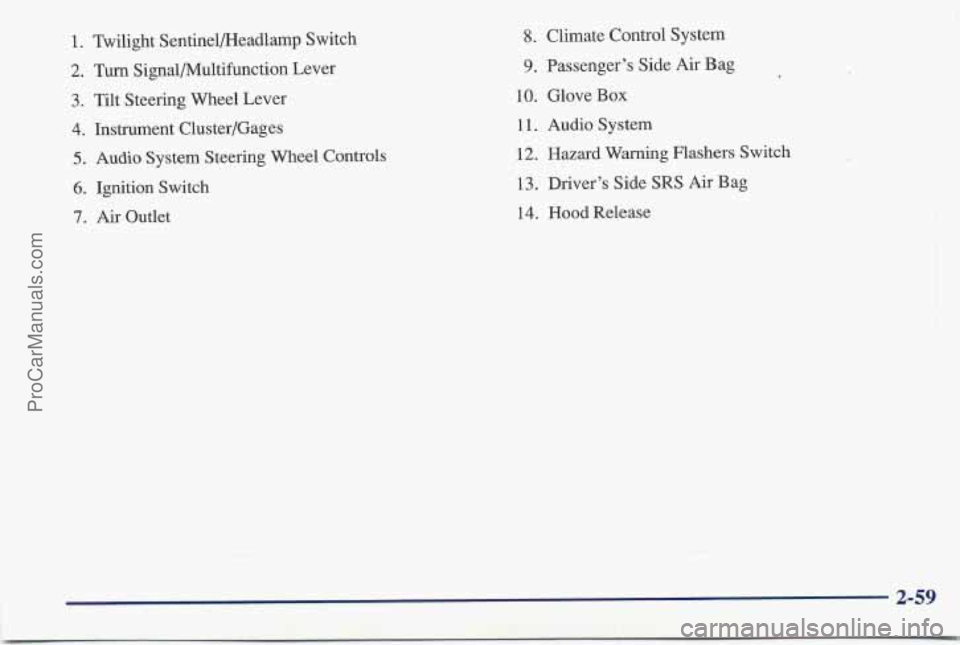
1. Twilight Sentinel/Headlamp Switch
2. Turn Signal/Multifunction Lever
3. Tilt Steering Wheel Lever
4. Instrument Cluster/Gages
5. Audio System Steering Wheel Controls
6. Ignition Switch
7. Air Outlet
8. Climate Control System
9. Passenger’s Side Air Bag
10. Glove Box
11. Audio System
12. Hazard Warning Flashers Switch
13. Driver’s Side SRS Air Bag
14. Hood Release
2-59
ProCarManuals.com
Page 119 of 405
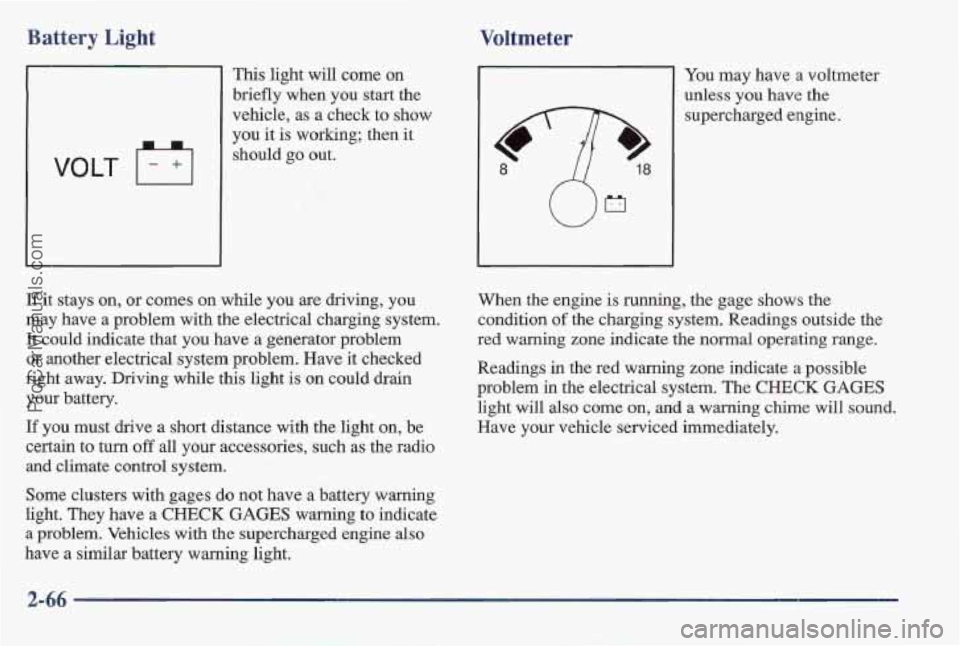
Battery Light Voltmeter
VOLT
This light will come on
briefly when you start the
vehicle, as a check to show
you it is working; then it
should go out.
You may have a voltmeter
unless you have the
supercharged engine.
If it stays on, OF comes on while you are driving, you
may have a problem with the electrical charging system.
It could indicate that you have a generator problem
or another electrical system problem. Have it checked
right away. Driving while this light is
on could drain
your battery.
If you must drive a short distance with the light on, be
certain to turn
off all your accessories, such as the radio
and climate control system.
Some clusters with gages do not have a battery warning
light. They have a
CHECK GAGES warning to indi'cate
a problem. Vehicles with th'e supercharged engine also
have
a simil'ar battery warning light. When the engine
is running, the
gage shows the
condition
of the charging system. Readings outside the
red warning zone indicate the normal operating range.
geadings
in the red warning zone Indicate a possible
problem
in the electrical system. The CHECK GAGES
light will also come on, and a warning chime will sound.
Have your vehicle serviced immediately.
2-66
ProCarManuals.com
Page 142 of 405
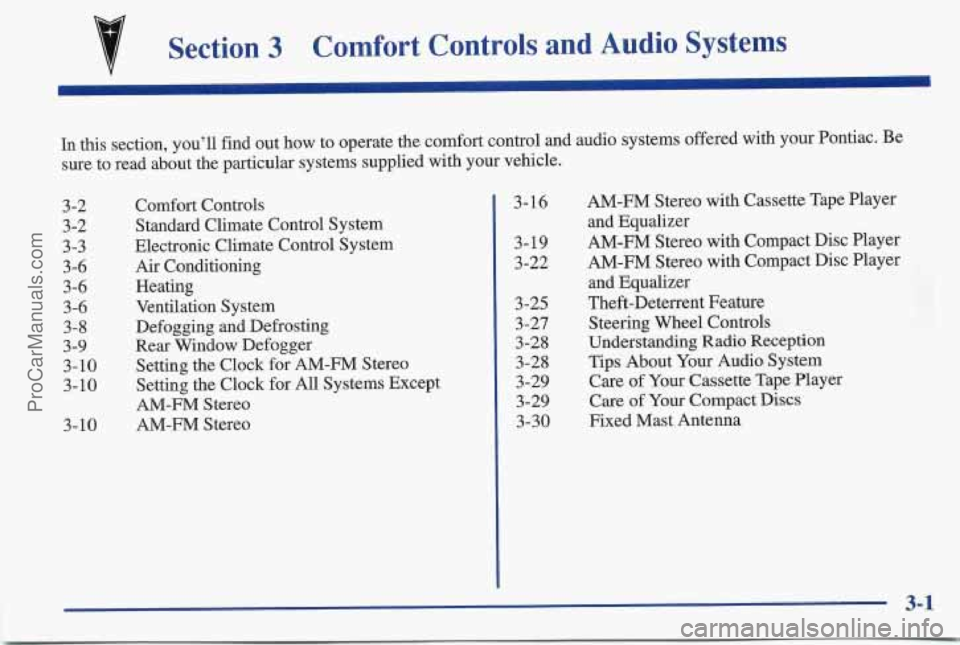
Section 3 Comfort Controls and Audio Systems
In this section, you’ll find out how to operate the comfort control and audio systems offered with your Pontiac. Be
sure to read about the particular systems supplied with your vehicle.
3-2 3-2
3-3
3-6 3-6
3-6
3-8
3-9
3-10 3-10
3-10 Comfort Controls
Standard Climate Control System
Electronic Climate Control System Air Conditioning
Heating
Ventilation System
Defogging and Defrosting
Rear Window Defogger
Setting the Clock for AM-FM Stereo
Setting the Clock for All Systems Except
AM-FM Stereo
AM-FM Stereo 3-16
3-19 3-22
3-25 3-27
3-28
3-28 3-29 3-29
3-30 AM-FM Stereo with Cassette
Tape Player
and Equalizer
AM-FM Stereo with Compact Disc Player AM-FM Stereo with Compact Disc Player
and Equalizer
Theft-Deterrent Feature Steering Wheel Controls
Understanding Radio Reception
Tips About Your Audio System
Care of Your Cassette Tape Player
Care
of Your Compact Discs
Fixed Mast Antenna
3-1
ProCarManuals.com
Page 143 of 405
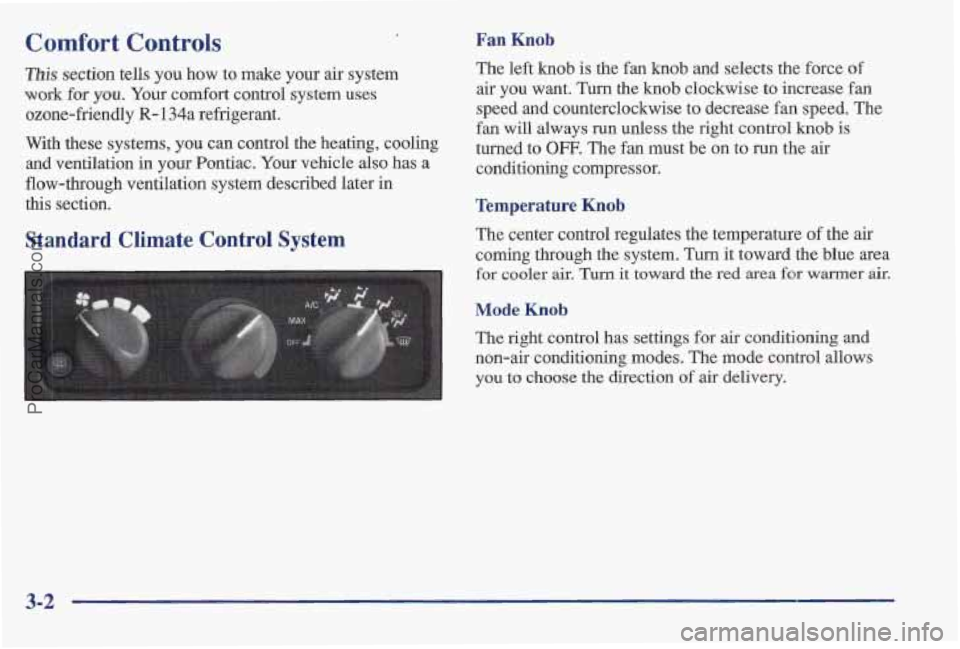
Comfort Controls
This section tells you how to make your air system
work for
you. Your comfort control system uses
ozone-friendly
R- 134a refrigerant.
With these systems, you can control the heating, cooling
and ventilation
in your Pontiac. Your vehicle also has a
flow-through ventilation system described later in
this section.
Standard Climate Control System
Fan Knob
The left knob is the fan knob and selects the force of
air you want. Turn the knob clockwise to increase fan
speed
and counterclockwise to decrease fan speed. The
fan will always
run unless the right control knob is
turned to
OFF. The fan must b'e on to run the air
conditioning compressor.
Temperature Knob
The center control regulates the temperature of the air
coming through the system. Turn it toward the blue area
for cooler air. Turn it toward the red area for warmer air.
Mode Knob
The right control has settings for air conditioning and
non-air conditioning modes. The mode control allows
you to choose
the direction of air delivery.
3-2
ProCarManuals.com
Page 144 of 405
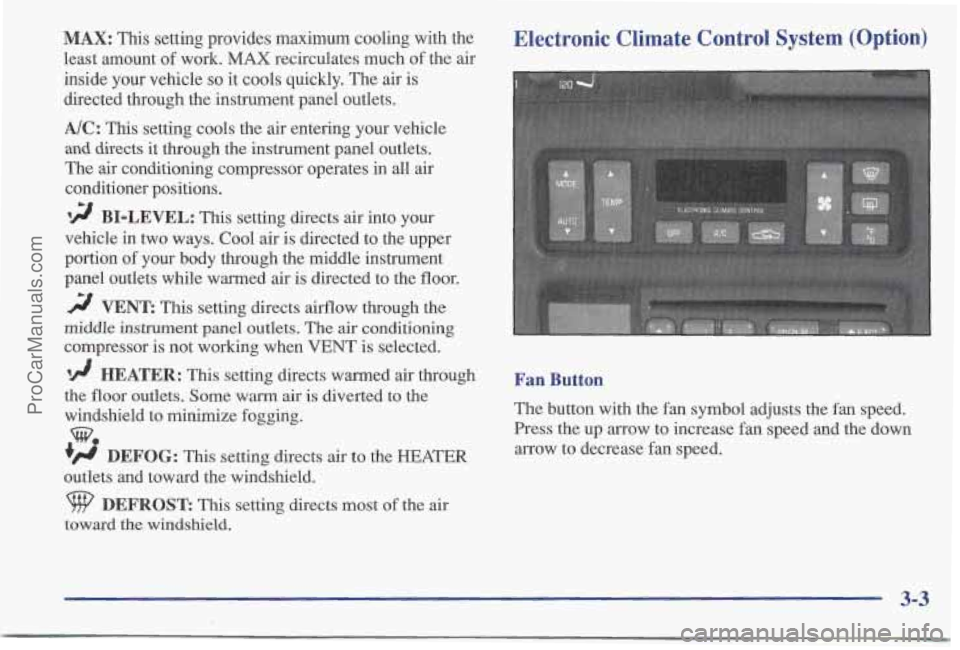
MAX: This setting provides maximum cooling with the
least amount
of work. MAX recirculates much of the air
inside your vehicle
so it cools quickly. The air is
directed through the instrument panel outlets.
A/C: This setting cools the air entering your vehicle
and directs
it through the instrument panel outlets.
The air conditioning compressor operates in all air
conditioner positions.
12 BI-LEVEL: This setting directs air into your
vehicle in two ways. Cool air is directed to the upper
portion of your body through the middle instrument
panel outlets while warmed air is directed to the floor.
2 VENT This setting directs airflow through the
middle
instrument panel outlets. The air conditioning
compressor is not working when
VENT is selected.
'I! HEATER: This setting directs warmed air through
the floor outlets. Some warm air is diverted to the
windshield to minimize fogging.
+# DEFOG: This setting directs air to the HEATER
outlets and toward the windshield.
w.
DEFROST This setting directs most of the air
toward the windshield.
Electronic Climate Control System (Option)
Fan Button
The button with the fan symbol adjusts the fan speed.
Press the up arrow to increase fan speed and the down
arrow to decrease fan speed.
3-3
ProCarManuals.com
Page 300 of 405
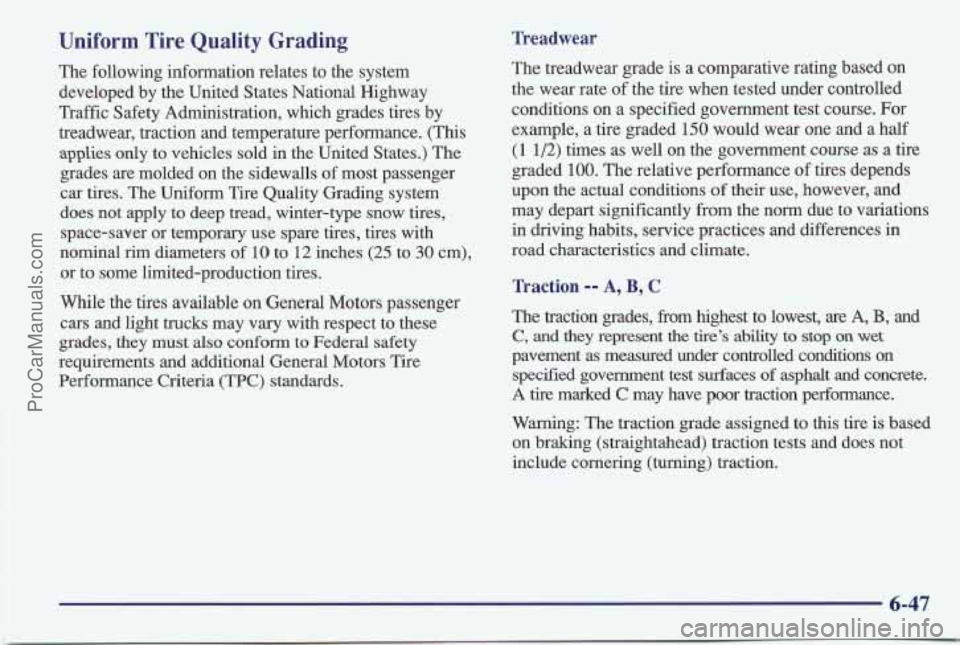
Uniform Tire Quality Grading
The following information relates to the system
developed by the United States National Highway
Traffic Safety Administration, which grades tires by
treadwear, traction and temperature performance. (This
appLies
only to vehicles sold in the United States.) The
grades are molded on the sidewalls
of most passenger
car tires. The Uniform Tire Quality Grading system
does not apply to deep tread, winter-type snow tires,
space-saver or temporary use spare tires, tires with
nominal rim diameters
of 10 to 12 inches (25 to 30 cm),
or to some limited-production tires.
While the tires available on General Motors passenger
cars and light trucks may vary with respect to these
grades, they must also conform to Federal safety
requirements and additional General Motors Tire
Performance Criteria (TPC) standards.
Treadwear
The treadwear grade is a comparative rating based on
the wear rate
of the tire when tested under controlled
conditions on a specified government test course. For
example, a tire graded 150 would wear one and a half
(1
1/2) times as well on the government course as a tire
graded
100. The relative performance of tires depends
upon the actual conditions
of their use, however, and
may depart significantly from the norm due to variations
in driving habits, service practices and differences in
road characteristics and climate.
Traction -- A, B, C
The traction grades, from highest to lowest, are A, B, and
C, and they represent the tire’s ability to stop on wet
pavement as measured under controlled conditions on
specified government test surfaces of asphalt and concrete.
A tire marked C may have poor traction performance.
Warning: The traction grade assigned to this tire is based
on braking (straightahead) traction tests and does not
include cornering (turning) traction.
6-47
ProCarManuals.com